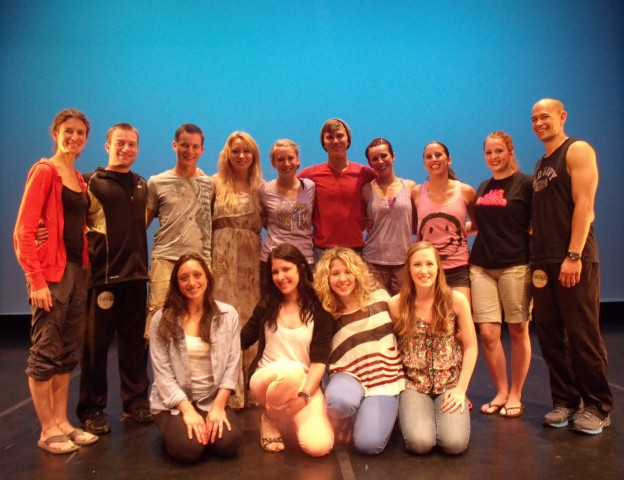by Gillian Ellis

The public face of our music, theatre and dance programs is almost inevitably a performance, but behind the scenes there is often much more than rehearsal time. There is an academic class. In this first in an occasional series of articles about the academic work we do to prepare our students for a life in the performing arts, we will investigate how our dance program teaches choreography.
Choreography is taught through four levels at OU. Levels one and two are taught by Assistant Professor Thayer Jonutz to both dance majors and minors. Only dance majors can enroll in Choreography Three and Four, which are taught by Assistant Professor Ali Woerner. The two professors, who often perform together, have similar philosophies of choreography and they collaborate on their syllabi to ensure development through the program is harmonious for their students.
In Choreography One, Thayer says he offers the students lots of opportunities for improvisation. He says, “The aim is to free them up.” In Choreography Two he really focuses on the essentials. “The founding elements of choreography are time, space and energy.” He introduces these concepts and uses exercises to help the dancers see how they can begin with an idea and use creative movement to form it into something that can be communicated to an audience. He also uses a text book to facilitate and encourage discussion. Thayer’s aim is to change each student’s mindset about choreography and to aid in this he will, for example, insist that they not use the kind of music that is easy to work with – popular music with a steady beat. An assignment may require students to record their own track of 'found sound' to develop choreography to. At a recent end of semester recital there were dances set to the sound of waterfalls, steam trains and a moving elevator.
Thayer admits that not all of his students' experiments are equally successful, but the lesson is in the process, not the final product, and it is on the process that students are graded. By the time a student has completed this level, the professors say that he or she should have at their command all the basic tools they would need to, for example, choreograph in a small studio.
More advanced dancers go on to Choreography Three, which Ali says is very fast paced. Within the course of one semester she will have them choreograph 6 different studies: a solo, a duo, a trio, a quartet, a dance for the camera and a piece for their final. All this is, more or less, a new dance every week. They are also required to create a file of 40 pieces of music, covering at least 9 different genres. And each week they must bring to class dance reviews or articles for discussion. “And every day,” says Ali, “I ask them to justify their movement, to explain the point of what they are communicating.” She wants them never to be satisfied and is constantly asking them to find another way to initiate a phrase. “How can I do it differently?” is the question she wants them to have at the forefront of their minds.
By contrast, Choreography Four, which is taken only by B.F.A. students, gives dancers time to luxuriate in the process of producing polished work. Students are asked to choreograph only one solo and one group piece, and Thayer and Ali agree that completion of this class should be seen as the equivalent of writing a thesis. Dancers have a couple of months to, as Thayer says, “Really live with their concept, process and content.”
But even at this level, students are graded on their own process. “It’s important,” says Ali, “not to compare students to each other. They start at different places.”
Of course, once they are out in the real world, dancers are compared to each other all the time, especially if they are competing for jobs in professional companies through the audition process. And it is at this point that these intensive choreography classes may yield the most benefit.
Years ago dancers were expected to do exactly what they were told to do, nothing more and nothing less, and while that may still be true in the world of classical ballet, Thayer and Ali agree it is most definitely no longer the case in the world of modern dance. Even the biggest companies now expect dancers to be able to “create their own phrase when they audition,” says Thayer. “Modern choreographers eat that up.”
Both professors run their own professional companies, as well as student companies on campus, and Ali says, “We want input. We want intelligent, supportive, collaborative dancers. We are very selective. Even the most beautiful dancer is going to be less successful today if they don’t understand the mechanics of choreography.”
There are many opportunities to see OU faculty and student dance and choreography during our 2012/2013 performance season. If you don’t currently receive our Season Brochure please contact us at
mtd@oakland.edu or call (248) 370-2030 so we can find the best way to keep you updated with our performance information.
Photo: Students from Choreography Two and Three with Professors Ali Woerner (left) and Thayer Jonutz (right). Photo by Gillian Ellis.
